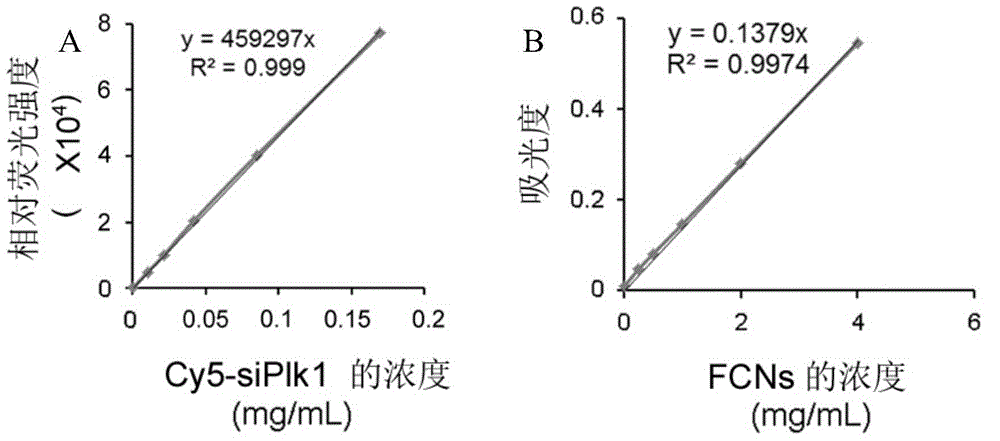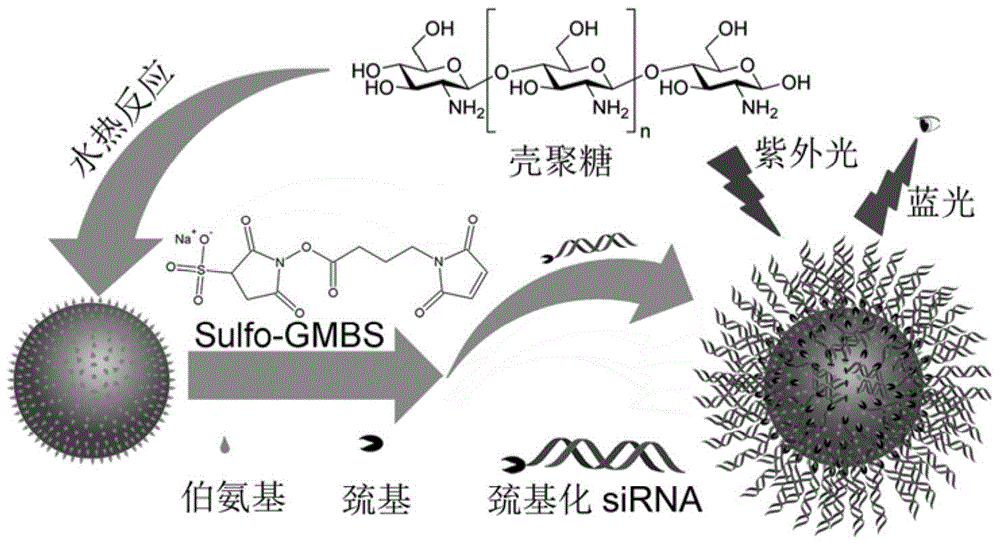FCN (Fluorescent carbon nano-particle) based visual spherical nucleic acid as well as preparation method and application thereof
A carbon nanoparticle and nucleic acid technology, applied in the visualization of spherical nucleic acid and its preparation, based on fluorescent carbon nanoparticles in the field of visualization of spherical nucleic acid and its preparation, can solve the problems of limited application range of FCNs, and achieve easy scale and promotion, high efficiency Delivery to, low cost effect
- Summary
- Abstract
- Description
- Claims
- Application Information
AI Technical Summary
Problems solved by technology
Method used
Image
Examples
Embodiment 1
[0046] Embodiment 1: Preparation and separation and purification of fluorescent carbon nanoparticles (FCNs)
[0047] (1) Preparation of fluorescent carbon nanoparticles (FCNs):
[0048] Using low-molecular-weight chitosan as a raw material, carbon nanoparticles with good fluorescence characteristics were obtained by hydrothermal synthesis. The preparation method was: weigh 0.35 g of low-molecular-weight chitosan and add it to 70 mL of deionized water while fully stirring. Then place it in an airtight container (autoclave) for 12 hours of reaction at a temperature of 180°C.
[0049] (2) Separation and purification of fluorescent carbon nanoparticles (FCNs):
[0050] The resulting product solution was centrifuged in a high-speed desktop refrigerated centrifuge (14000 rpm) for 10 min, and then treated with a dialysis bag (molecular weight cut-off 1000 Da) to remove small molecular substances, and the dialysis time was 2 days.
Embodiment 2
[0051] Embodiment 2: Characterization of properties of fluorescent carbon nanoparticles (FCNs)
[0052] (1) Fourier infrared spectroscopy of fluorescent carbon nanoparticles
[0053] figure 2 A is the infrared spectrogram of fluorescent carbon nanoparticles, composed of figure 2 A It can be seen that the fluorescent carbon nanoparticles prepared in Example 1 have an N-H stretching vibration absorption peak at around 1660-1580.
[0054] (2) High-definition transmission electron microscope characterization of fluorescent carbon nanoparticles
[0055] figure 2 B is the high-definition transmission electron microscope characterization diagram of fluorescent carbon nanoparticles, by figure 2 B, it can be seen that the particle size of fluorescent carbon nanoparticles is 11.83±2.22nm, and the particle size distribution is relatively uniform, and the monodispersity is good.
[0056] (3) Imaging of fluorescent carbon nanoparticles
[0057] figure 2 C is the picture of fluo...
Embodiment 3
[0058] Example 3: Cytotoxicity Test of Fluorescent Carbon Nanoparticles (FCNs)
[0059] Put MDA-MB-231 and A375 cells into a 96-well plate at a density of 5000 / well in 5% CO 2 , and incubated in a 37°C incubator for 24h. Fluorescent carbon nanoparticles (FCNs) were added at concentrations of 0, 10, 20, 50, 80, 100, 150, 200, 250, 300 and 350 μg / mL, respectively. 5 replicate wells for each concentration. After 48 hours, suck out the culture medium, add and replace with 200 μL freshly prepared 3-(4,5-dimethylthiazole-2)-2,5-diphenyltetrazolium bromide at a concentration of 5 mg / ml in each well (MTT) solution, continue culturing for 4 hours, suck out the culture medium in the wells, add 200 μL of dimethyl sulfoxide to each well, shake on a shaker at low speed for 10 minutes, and fully dissolve the crystals. The absorbance of each well was measured at OD490nm in an enzyme-linked immunosorbent assay instrument.
[0060] Depend on image 3 It can be seen that the toxicity of th...
PUM
 Login to View More
Login to View More Abstract
Description
Claims
Application Information
 Login to View More
Login to View More - R&D
- Intellectual Property
- Life Sciences
- Materials
- Tech Scout
- Unparalleled Data Quality
- Higher Quality Content
- 60% Fewer Hallucinations
Browse by: Latest US Patents, China's latest patents, Technical Efficacy Thesaurus, Application Domain, Technology Topic, Popular Technical Reports.
© 2025 PatSnap. All rights reserved.Legal|Privacy policy|Modern Slavery Act Transparency Statement|Sitemap|About US| Contact US: help@patsnap.com



